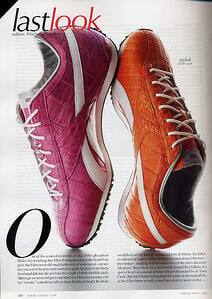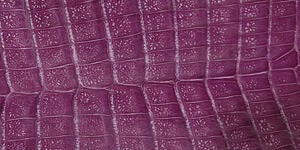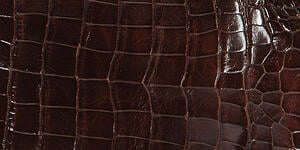
When it comes to making footwear out of exotic leathers such as crocodile skin, you want to make sure that whatever you make is as perfect as possible. From the size and shape of the shoe to the coloration of the scales, everything has to be just so for your final product to meet your vision.
In all, there are 23 different species of crocodile. However, less than half of these species are used commercially for their skins. Currently, three of the most popular crocodile skins are the caiman crocodile, Nile crocodile, and the American alligator.
Each of these three skins differs from the others in terms of cost, softness, coloration, available sizes and even country of origin. It is these factors that should ultimately determine which type of skin you order.
That being said, here are some quick details about each of the three crocodile hides:
The Caiman
 Of the three most popular crocodile skins, the caiman is the least expensive by far. This relative cost can be attributed to the fact that caiman skin is the boniest of the three, making it more difficult and time-consuming to work with than Nile crocodile or American alligator skin. Because the hide of the caiman is bony, the scales retain some calcium markings and are firmer than the scales of the other crocodilian species.
Of the three most popular crocodile skins, the caiman is the least expensive by far. This relative cost can be attributed to the fact that caiman skin is the boniest of the three, making it more difficult and time-consuming to work with than Nile crocodile or American alligator skin. Because the hide of the caiman is bony, the scales retain some calcium markings and are firmer than the scales of the other crocodilian species.
For the most part, caiman skins are measured between the outer edges at the widest point of the belly. For smaller size shoes or boots, a skin that is between 30 and 34 centimeters wide is fine. However, for larger sizes, you will probably need a skin of more than 35 cm.
Tanneries and distributors typically have somewhere between 10 to 20 different colors of caiman skin available.
The Nile Crocodile
Nile crocodile hides are the median option on this list when it comes to price. On average, Nile crocodile skin for footwear will cost three times as much as a comparable caiman hide, but will still be approximately 15 percent less expensive than a similar alligator hide.
Overall, the skin of a Nile crocodile is much less bony than the skin of a caiman, making it easier to work with. Where the caiman’s hide is measured only at the widest point of the belly, a Nile crocodile skin is measured between the center portion of the innermost bones on each side of the widest point of the belly. Given this measurement method, the best size of skin to use is roughly 25 to 29 cm for small shoes and boots, and 30 to 34 cm for larger pieces of footwear.
Being more expensive to acquire than caiman, Nile hides are usually stocked in fewer colors by tanneries and distributors. At best, you’ll find 5-10 colors of these hides in stock at any given time.
The American Alligator
The hide of the American alligator is one of the most prized exotic leathers there is. As such, it is the most expensive of the skins on this list. Unlike the caiman and the Nile crocodiles (which hail from Central America and Africa, respectively), the American alligator is an animal that is born and bred in the USA. Collected largely from specialized farms in the southern USA, alligator is a supple and luxurious material.

Of the three crocodilians, alligators have the least bony skin of all, making dyeing the hide and sewing it a breeze by comparison to the other two. This makes alligator hide ideal for a number of uses, including footwear.
Alligator hides are measured in the same way as Nile croc hides, between the center of the innermost bones on each side of the widest point of the belly. As such, the same sizes of alligator skin are used for footwear as the Nile croc skins.
Being the most expensive skin, alligator is also one of the hardest skins to keep in stock. The investment required to stock alligator skin prevents most distributors from stocking more than one or two colors at a time. If you want a particular color/finish, you may need to go straight to a tannery with a production order.
Quick Tips for Making Footwear out of Any Crocodilian Hide:
If you are making shoes or any other paired item out of crocodile hides, be sure to order your hides in pairs. This is because if you order just one skin, you would end up using the belly of the animal for one shoe/boot and the tail for the other. These two parts of the animal have very different scale patterns, which would create an uneven look. To combat this problem, order two hides and create two pairs of shoes, one from the matching bellies and one from the matching tails.
Also, to save some money, you can utilize grade 2 skins if the defects are located towards the tops or bottoms of the bellies and tails of the hide. On any of these exotic materials, grade 2 skins are cheaper and easier to find.
If budget is a major issue, caiman skin might be your best bet. For value, Nile crocodile skin is your best bet. If money isn’t an issue, and you want the greatest luxury as well as the ability to say “made in America” all the way, American alligator skin will certainly turn heads.



